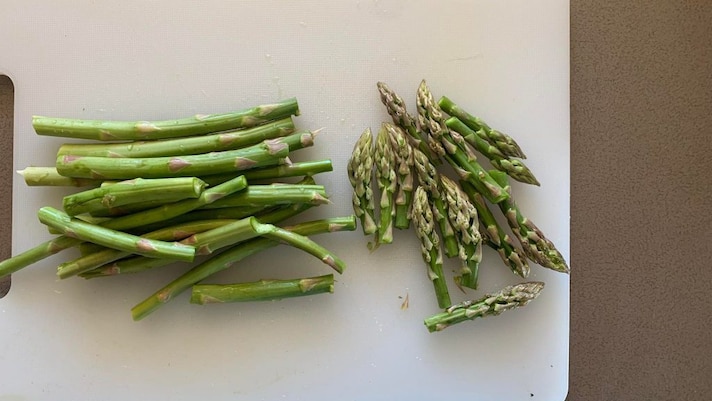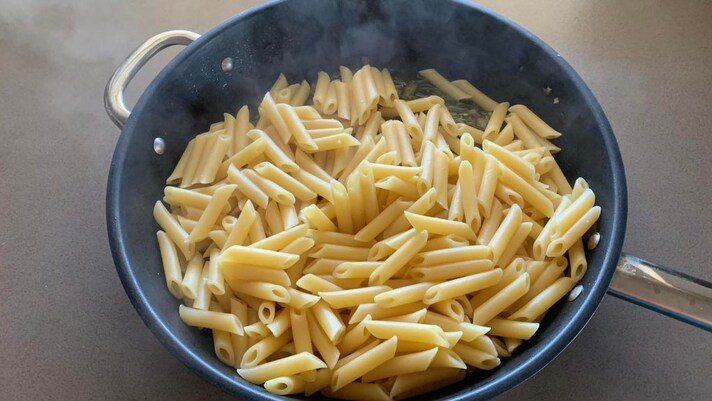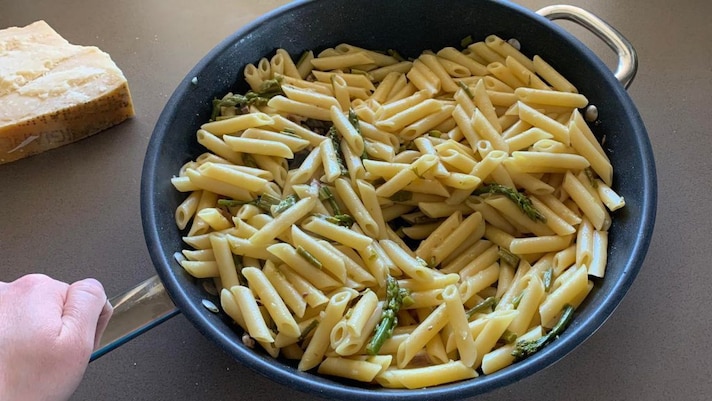
Asparagus pasta is a delicious, fresh vegetarian-friendly dinner that screams springtime. It's a bright, fresh way to enjoy seasonal asparagus in spring. Pasta with asparagus is delicious and zesty thanks to a squeeze of lemon juice and a dash of lemon zest. It also has a wonderful buttery, garlicky flavor that's hard to resist. Of course, there's plenty of crispy asparagus in this dish, a mouthwatering foil to the tender pasta.
Asparagus pasta is super easy to make, and you can add other ingredients if you want a little more protein or veggies in the dish. Pasta with asparagus only takes about 25 minutes to make, so it's ideal for those busy weeknights. Enjoy it with a crisp glass of white wine and some garlic bread, and enjoy the start of spring.
What is the Best Pasta Shape for Asparagus Pasta?
You can use pretty much any shape of pasta you like for this recipe. Pasta that's roughly the same size as the asparagus makes for easy eating. Penne, fusilli, gemelli, and campanelle all work wonderfully in this recipe. Of course, you can chop your asparagus quite small and use macaroni or shells.
How Do You Cut Asparagus for Pasta?
You want smallish pieces of asparagus for this dish. About bite-sized is ideal. Aim to chop the asparagus roughly the same size as the pasta you're using.
How to Cook Asparagus for Pasta
The secret to great-tasting asparagus pasta is to cook the asparagus perfectly. First, gently simmer it for a minute or two in about an inch of water. Once it becomes slightly tender and turns bright green, drain off the water.
Pop the asparagus back in the pan together with bacon if used. Sauté it in butter with the garlic for another 2 minutes or so, then take the pan off the heat.
Tips for Making Pasta with Asparagus
Cook the pasta according to the instructions on the box for al dente. This means it should be tender but still slightly firm. You don't want to overcook the pasta. Otherwise, it will have an unpleasant mushy texture. Of course, you don't want to undercook it either, as it will be too hard to eat.
To make a vegan-friendly asparagus pasta, use oil or plant-based spread instead of butter.
As long as you don't overcook the asparagus when it's simmering in the skillet, there's no need to blanch it.
Don't be tempted to use bottled lemon juice for this recipe. Not only would the dish not taste as good, but you also need lemon juice and lemon zest to make asparagus pasta.
When zesting the lemon, only zest the yellow peel, not the bitter white pith.
For a heartier pasta dish, try adding chicken, sausage, or shrimp to your asparagus pasta.
You can easily add more vegetables to this pasta dish. Broccoli, cherry tomatoes, zucchini, and bell pepper make fantastic add-ins.
Try adding fresh chopped herbs or some grated parmesan to your asparagus pasta.
How to Store Asparagus Pasta
Keep leftover asparagus pasta in an airtight container in the fridge. Reheat and enjoy within 3 days.
Ingredients
How to Make Asparagus Pasta
Following the instructions on the packet, cook the pasta to al dente. Keep ½ cup of pasta water and drain the rest.

Following the instructions on the packet, cook the pasta to al dente. Keep ½ cup of pasta water and drain the rest.
Cut the asparagus into 1-inch pieces and remove the woody stalks.

Cut the asparagus into 1-inch pieces and remove the woody stalks.
Put the asparagus and ½ inch of water into a large skillet. Cover with a lid and bring the water to a boil. Simmer for 2 minutes, until slightly tender. Drain, then place asparagus back in the pan.

Put the asparagus and ½ inch of water into a large skillet. Cover with a lid and bring the water to a boil. Simmer for 2 minutes, until slightly tender. Drain, then place asparagus back in the pan.
Stir butter and garlic into the skillet. Sauté over medium heat for 2 minutes. Remove from heat.

Stir butter and garlic into the skillet. Sauté over medium heat for 2 minutes. Remove from heat.
Place pasta in the skillet.

Place pasta in the skillet.
Toss to combine. Season with salt and pepper. Zest the lemon over the pasta. Cut the lemon in half and squeeze it over the pasta.

Toss to combine. Season with salt and pepper. Zest the lemon over the pasta. Cut the lemon in half and squeeze it over the pasta.
Toss to combine, adding pasta water if needed. Serve.
Notes
Don't forget to taste the dish before serving to see if the seasoning is to your liking. You can always add an extra dash of salt, pepper, or a spritz more lemon juice.
;Resize,width=767;)
